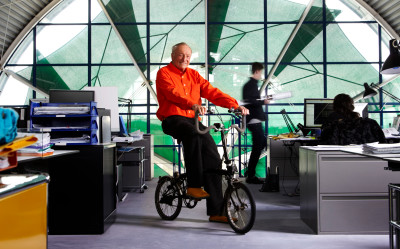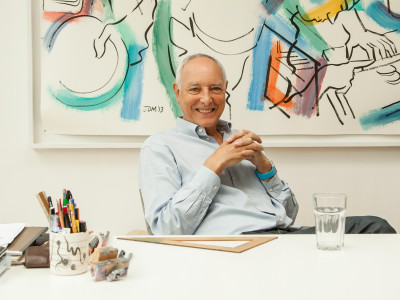Remembering Leonard Manasseh RA
Remembering Leonard Manasseh RA
By Trevor Dannatt RA
Published 19 May 2017
The architect Leonard Manasseh, the first Royal Academician to reach the age of 100, passed away in March. Fellow architect Trevor Dannatt looks back on more than half a century of rivalry, collaboration and friendship.
-
In 1938 Leonard Manasseh RA (1916-2017) was finishing his architectural studies whereas I was commencing mine, albeit at a different school. Leonard was at the Architectural Association School of Architecture and I was at the Regent Street Polytechnic. Our paths crossed a few years later at an Arts Council exhibition of modern British architecture, for which I was the designer.
The show included one of Leonard’s buildings, the Frenchay Engineering office in Kingswood, near Bristol. We established a relationship and found common ground when we were both involved with designing restaurants and cafés. For the Festival of Britain in 1951 we both designed bars: mine was for tea, his (the ‘51 Bar, above) was licensed! In Baker Street (close to my office) Leonard created a notable fish restaurant, Hook, Line and Sinker, of delightful character, subtle and rich in colour and with a whimsical touch that is difficult to define. This whimsical quality appears in Leonard’s buildings without diminishing their serious purpose. Perhaps it is more appropriate to call it a lightness of touch.
-

Leonard Manasseh RA, Design for Radipole Lake pumping station, for Weymouth and Portland Borough Council, Weymouth, Devon: plan, elevation and section, 9 April 1979.
Diploma Work, accepted 1979–80.
Print with black ink, on paper, with pencil, grey, blue and turquoise crayon added and two paper labels, printed with black ink. 83.50 x 98.0 cm. Photo credit: © Royal Academy of Arts, London.
-
Such lightness of touch was very much exemplified in the National Motor Museum at Beaulieu (1972), which Leonard designed with two colleagues, Ian Baker and Elizabeth Chesterton. With this museum, the “object” (building) serves the “subject” (exhibits) rather than dominating it. It was one of his major works, along with the Rutherford School (1958–60) in Paddington. ?
Of course, in the beginning, Leonard and I were leading rival practices, but a friendly respect developed between us, especially when we were both working for the London County Council, on different projects on opposite sides of Welham Road, Streatham. This was long before we became Architect RAs (elected just a year apart from one another, Leonard in 1976 and myself in 1977), when a closer friendship developed despite the north/south London divide. Conviviality and affection flowed whether in Highgate (where Leonard lived), Peckham (where I lived) or at Leonard’s house in France. He and his second wife Sarah Delaforce were great hosts and their home, which Leonard designed, was a treasure trove – not least because of his own paintings, which went beyond the lighter bonne bouche delights of his annual offerings in the Summer Exhibition, showing his fine sense of design and singular palette.
-
The Royal Academy was a great love of Leonard’s and among other Academicians he had a profound regard for H.T. (‘Jim’) Cadbury-Brown, architect of the much-admired RA Library and of course the Royal College of Art building next to the Royal Albert Hall. Leonard’s commitment was characteristic and in another sphere he committed himself to presidency of the Royal West of England Academy (1989–95) and did much for that institution.
In my scheme of things, architecture is a way of life before the means of life and I believe Leonard followed that dictum too. He was seriously committed, commanding loyalty and affection from others, as well as giving it himself.
Trevor Dannatt RA is an architect whose buildings include London’s Royal Festival Hall.







